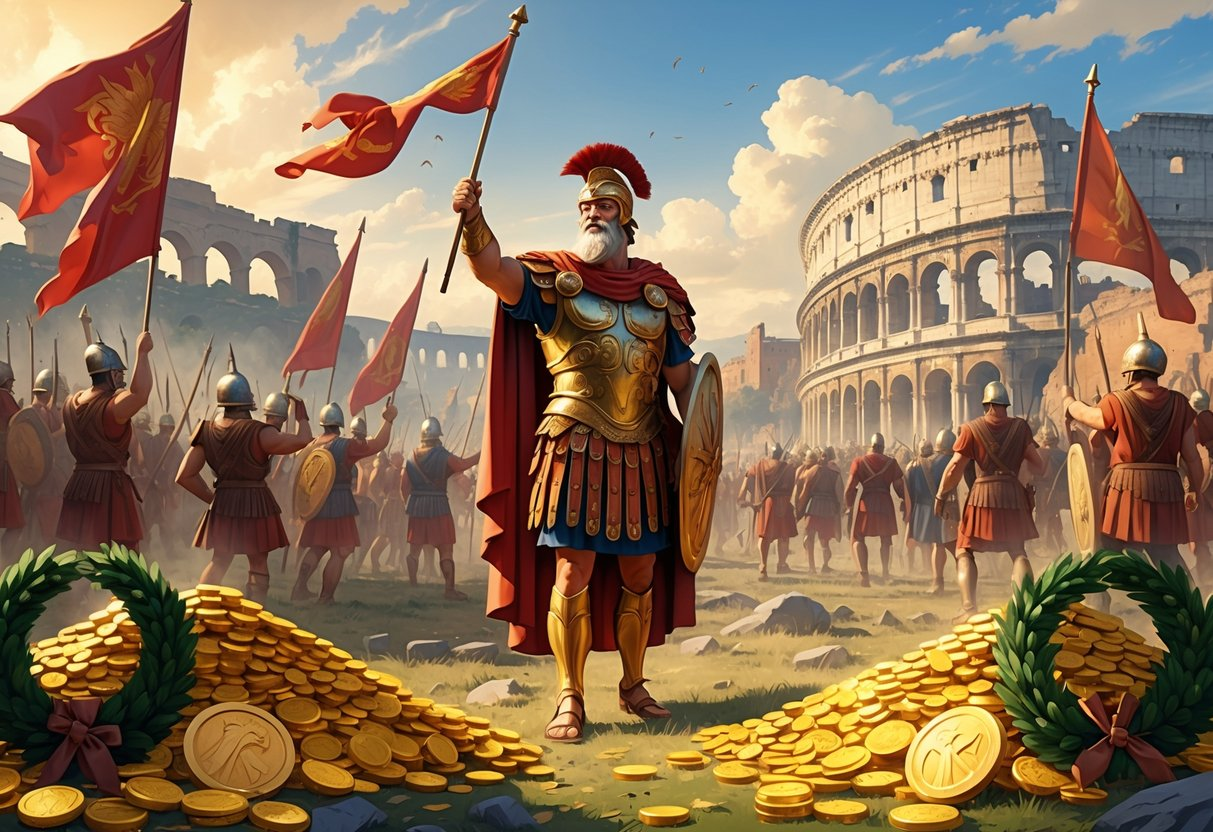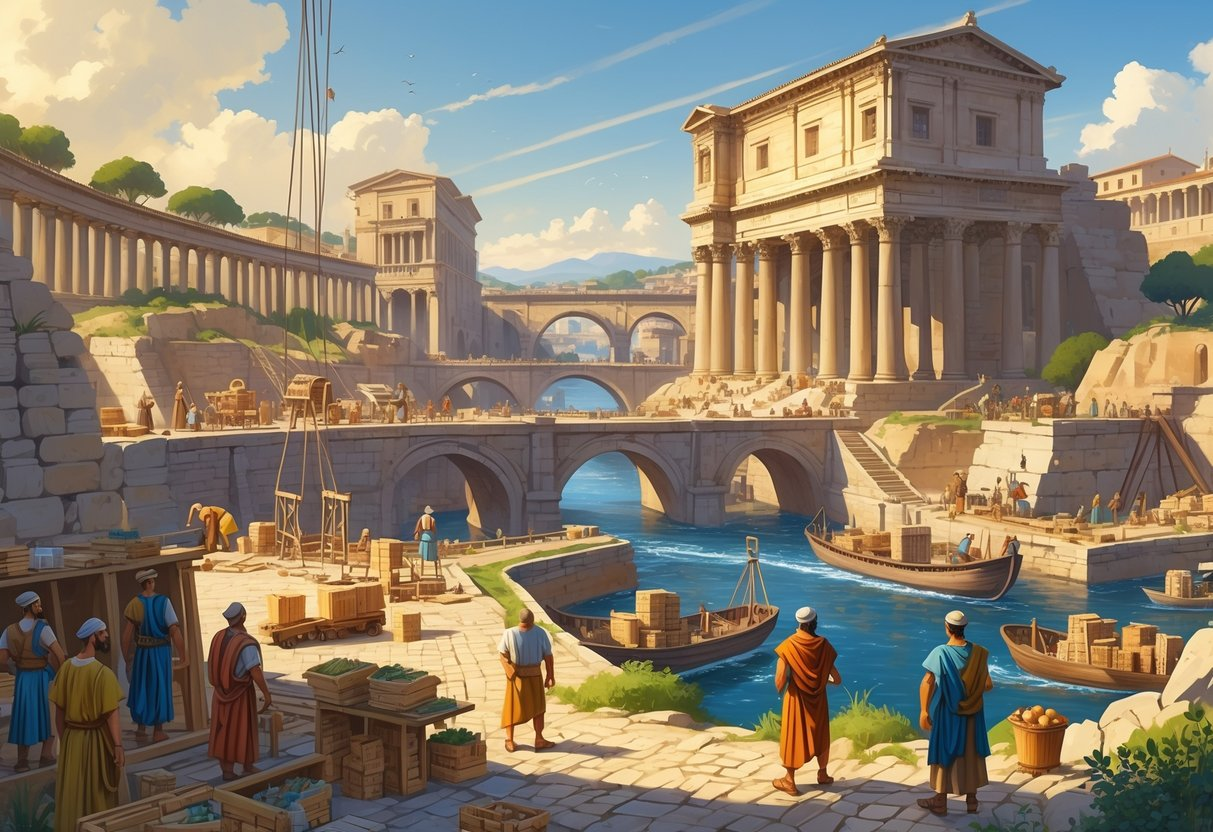War played a huge role in shaping Rome’s fortune and empire. Each victory brought new lands and streams of wealth, fueling its rise from a small city-state to a Mediterranean power.
Rome’s conquests built its wealth by turning military success into economic growth through captured resources, tribute, and expanded trade networks.

As Roman armies marched across Europe, Africa, and Asia, they brought home more than just glory. Gold, silver, and slaves from conquered territories filled Roman treasuries and paid for public works, temples, and the professional army.
Studies like Power and Public Finance at Rome, 264–49 BCE show how control over conquered wealth let Rome fine-tune its taxation and spending systems.
This transformation changed trade and city life, too. Expanding markets and the flow of money, as described in The Supply and Use of Money in the Roman World 200 BC to AD 300, helped cities grow and created a new class of wealthy elites.
The Economic Impact of Roman Conquest

Roman conquest totally changed the ancient Mediterranean economy by giving Rome control over land, labor, and wealth. Military victories brought in resources, tons of bullion, and a system that relied on enslaved labor to keep the empire growing and living large.
Expansion of Territory and Resources
Every military win gave Rome new provinces packed with minerals, farmland, and trade routes. Places like Spain and North Africa handed over silver, grain, and olive oil that fed the army and the cities.
The state collected taxes and rents from these territories, sometimes in money, sometimes in goods. Studies on taxes and trade in the Roman Empire show how this system pushed a money economy and connected far-off provinces through trade.
Controlling ports and shipping lanes let Rome call the shots on Mediterranean trade. Provinces supplied Italy, and Italy sent back manufactured goods and luxuries, making a self-reinforcing economic network.
Influx of Wealth and Treasures
War brought in cash fast—plunder, indemnities, and tribute. Victorious generals rolled into Rome with gold, silver, and art from defeated states.
One look at Rome’s economic revolution shows how this wealth made elite families even stronger.
The state cashed in from new mines and grabbed estates. Spanish silver mines alone pumped out so much bullion that it boosted the money supply and paid for huge city projects in Rome.
Here’s a simple table of where the money came from:
| Source of Wealth | Example | Economic Effect |
|---|---|---|
| Plunder | Loot from Carthage | Boosted treasury reserves |
| Tribute | Payments from provinces | Funded infrastructure |
| Mines | Silver in Spain | Expanded coinage circulation |
Acquisition and Use of Slave Labor
Roman victories brought in hundreds of thousands of enslaved people. These captives worked in farms, mines, and homes, powering production across the empire.
The use of slave labor let big estates in Italy and Sicily get even bigger and richer. Wealthy landowners swapped out small farmers for enslaved workers, building huge plantations that sent grain and wine to the cities.
This setup made inequality worse but also boosted city life and trade. Enslaved workers churned out much of Rome’s export goods, tying conquest directly to economic growth.
Taxation, Revenue, and Financial Administration

Rome’s financial muscle came from a mix of direct taxes, tribute from conquered lands, and revenues from state resources. All this money paid for wars, built cities, and kept the empire running.
Tax Collection in Conquered Territories
Roman officials quickly organized new provinces into taxable chunks after taking over. Local elites usually acted as go-betweens, collecting taxes and sending them to Rome, which made things smoother and kept costs down.
Early on, taxes were paid in stuff like grain or livestock. As trade and coins became more common, payments switched to money. The state also took over mines, ports, and customs duties, as shown in studies of Roman taxation and trade.
Tax farming was big during the Republic. Private contractors (publicani) bid for the right to collect taxes, paid the government upfront, and kept any extra. This sometimes led to abuse, so later emperors switched to direct collection by officials for more fairness.
Growth of Tax Revenue
As Rome’s borders grew, so did its tax base. New regions paid annual tribute and big one-time war indemnities. The state also grabbed land, turning it into ager publicus (public land) leased to wealthy Romans.
Here’s a quick look at where the money came from:
| Type of Revenue | Description | Example |
|---|---|---|
| Tribute | Annual payments from provinces | Spain, Asia Minor |
| Taxes | Land, poll, and customs taxes | Egypt, Gaul |
| State Resources | Mines, salt works, and ports | Silver mines in Spain |
By the late Republic, silver from Spanish mines and provincial taxes paid for wars and city projects.
Funding Public Works and the Military
Tax money kept the Roman army going and paid for huge infrastructure. Soldiers’ pay, gear, and pensions all came from the treasury, which depended on steady cash flow from the provinces.
Public funds built roads, aqueducts, and temples that showed off Roman power. According to The revenues of Rome, these projects created jobs and made trade and army movement easier.
Victories brought new provinces and more tax income, which then paid for more expansion. This cycle of conquest and revenue let Rome keep a pro army and a wealthy, stable state.
Trade, Goods, and Urban Economic Growth
Rome’s wealth grew thanks to organized trade, steady agricultural exports, and booming cities. The economy ran on goods moving across the Mediterranean and smart use of conquered lands for farming and making stuff.
Expansion of Trade Routes
Roman conquest opened up safe routes all over Europe, North Africa, and the Near East. The Mediterranean was basically the empire’s main highway, connecting ports to the capital.
Merchants shipped bulk goods like grain and wine by sea, while roads like the Via Appia handled inland trade. Archaeologists have found shipwrecks and amphorae that show just how busy this network was.
Roman shipping could carry hundreds of tons at a time, which means trade was big and organized. Provinces specialized—Spain in metals, Egypt in grain, Syria in textiles.
As trade picked up, more taxes and rents were paid in coins, creating a cash economy that helped cities grow. This pattern is discussed in “Taxes and Trade in the Roman Empire (200 BC–AD 400)”.
Key Commodities: Grain, Olive Oil, and Luxury Goods
Grain was the backbone of Rome’s food supply and economy. Egypt and North Africa shipped millions of bushels every year to feed the city.
Grain imports kept food prices steady and let Rome support over a million people.
Olive oil was just as important. Provinces like Baetica in Spain exported oil in massive amphorae stamped with production marks.
These amphorae, found all over the Mediterranean, show how big the trade was and how organized it had to be.
Luxury goods like glassware, pottery, and spices traveled long distances from Asia and Red Sea ports. As noted in “Rome, Taxes, Rents and Trade”, elite demand for imports kept commerce buzzing.
| Commodity | Main Source Regions | Primary Use | Transport Method |
|---|---|---|---|
| Grain | Egypt, North Africa | Food supply | Ship |
| Olive Oil | Spain, Italy | Cooking, lighting | Amphorae by ship |
| Luxury Goods | Eastern Mediterranean, Asia | Status, trade | Caravan & ship |
Development of Roman Cities and Industry
Cities became the engines of production and trade. Places like Ostia, Pompeii, and Carthage ran warehouses, workshops, and markets tied to imperial trade.
Their industries included textiles, metalwork, and pottery, often using imported raw materials. The growth of towns matched the prosperity that followed conquest.
Archaeologists find more coins, tools, and fancy goods in Roman layers than in earlier ones, hinting at a better standard of living. Economic historians like Keith Hopkins in “In Search of Roman Economic Growth” say urban expansion depended on surplus production and efficient trade.
Roman cities were also administrative and cultural hubs. They collected taxes, distributed goods, and gave merchants stable markets.
As trade routes grew and wealth piled up in the cities, these places became lasting symbols of Rome’s economic power.
Long-Term Effects on the Roman Economy
Roman conquests changed trade routes, land ownership, and labor systems all around the Mediterranean. Expanding markets and the flow of wealth from provinces to Italy made the economy more complex and tied Rome’s prosperity to its empire.
Integration of Conquered Regions
Rome brought new territories into the fold with taxes, trade, and lots of building projects. Provinces like Gaul, Spain, and Egypt sent grain, metals, and slaves to keep Rome’s cities growing and the army well supplied.
Taxes, paid in cash or goods, kept the government running and made the elites in Rome even richer. Over time, Rome built a huge network of roads and ports, making it easier to move goods and soldiers all over the empire.
Archaeologists have found pottery and coins that show local economies became more focused on money after Rome took over. According to Taxes and Trade in the Roman Empire (200 BC–AD 400), imports to Italy went up during the High Empire, showing how regions became more connected and Roman shoppers wanted more stuff.
Socioeconomic Changes and Urbanization
War and new land deals made the rich even richer in Rome. Big estates took over many small farms, so lots of rural folks ended up moving to the cities.
This led to city populations booming and new markets popping up for goods and services. More trade meant more work for artisans, merchants, and local officials.
Cities like Rome, Alexandria, and Antioch turned into busy economic centers where money from taxes and rents moved around. The economy of the early Roman Empire points out that most of the benefits went to the wealthy, while poorer people had to rely on free grain and public projects to get by.
Urban growth also meant building roads, aqueducts, and ports. These projects gave people jobs for a while, but also made cities more dependent on the empire and stuff coming in from the provinces.
Legacy of Roman Wealth and Economic Systems
Rome’s economic structures left a big mark on later European economies. Its use of coinage, taxation, and long-distance trade networks stuck around long after the empire ended.
The transformation of economic life under the Roman Empire shows how money systems and administrative practices shaped economic growth for a long time.
Even when Rome stopped expanding, it still relied on rents, taxes, and imports from its provinces. These systems set the stage for how money and trade worked in medieval times.



Leave a Reply